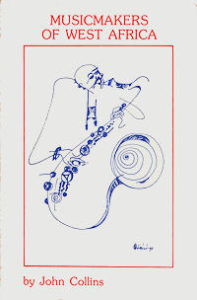> West Africa general (2 or more countries) | Books | Articles |
| Bénin | Burkina Faso | Cabo Verde | Côte d’Ivoire | Gambia | Ghana | Guiné-Bissau | Guinée | Liberia | Mali | Mauritanie | Niger | Nigeria | Sénégal | Sierra Leone | Togo |

See as well / Voir aussi / Veja também “Africa general – Books”
Amico, Marta:
La fabrique d’une musique touarègue.
Un son du désert dans la World Music.
Paris: Karthala, 2020. 320 p.
Table des matières
Barber, Karin; [Edmund] John Collins & Alain Ricard:
West African Popular Theatre.
Bloomington, Ind.: Indiana University Press &
Oxford: James Currey, 1997. 312 p.
Contents
Camara, Sory:
Gens de la parole.
Essai sur la condition et le rôle de griots dans la société Malinké.
Paris: Mouton, 1976. 358 p.
Table des matières
Charry, Eric:
Mande Music.
Traditional and Modern Music of the
Maninka and Mandinka of Western Africa.
Chicago, Ill. & London: University of Chicago Press, 2000. 500 p.
Contents
Coester, Markus:
Highlife on the Move.
Selected Nigerian & Ghanaian Recordings from London & Lagos 1954-66.
Soundway Records SNDW 060CD, 2015. 44 p. & 2 audio CDs / 12 p. & 3 LPs with bonus 7 inch.
Collins, [Edmund] John:
Musicmakers of West Africa.
Washington, D.C.: Three Continents Press, 1985. 177 p.
Contents
Collins, [Edmund] John:
West African Pop Roots.
Philadelphia, Pa.: Temple University Press, 1992. 349 p.
Contents
Collins, [Edmund] John:
Highlife Time.
Accra: Anamsesem Publications, 1994. xxii & 274 p.
Contents
Second revised edition
Accra: Anamsesem Publications,1996. xxi & 295 p.
Contents
Third revised edition
Highlife Time 3.
Accra: DAkpabli & Associates, 2018. 632 p.
Contents
Collins, [Edmund] John:
Highlife Giants: West African Dance Band Pioneers.
Abuja & London: Cassava Republic Press, 2016. 334 p.
Contents
Counsel, Graeme:
Mande Popular Music and Cultural Policies in West Africa.
Griots and Government Policy since Independence.
[Ph.D. The University of Melbourne, 2006. x & 318 p.]
Saarbrücken: VDM Verlag, 2009. 290 p.
Contents
Dave, Nomita:
From Praise Song to Protest: Music and Politics in West Africa.
M.Phil. University of Oxford, 2007. 122 p.
Dorsch, Hauke:
Globale Griots. Performanz in der afrikanischen Diaspora.
Beiträge zur Afrikaforschung, Band 23.
Berlin: Lit Verlag, 2006. 290 & XLIX p.
Inhalt
Dramé, Adama & Arlette Senn-Borloz:
Jeliya êntre griot et musician aujourd’hui.
Paris: L’Harmattan, 1992. 366 p.
Table des matières
Durán, Lucy & Graham Furniss (eds.):
Sunjata, Gambian versions of the Mande epic by Bamba Suso and Banna Kanuteh.
London: Penguin Classics, 1999. 160 p.
Contents
Hale, Thomas and Aissata Sidikou (eds.):
Women’s Songs from West Africa.
Bloomington, Ind.: Indiana University Press, 2014. 352 p.
Contents
Lee, Hélène:
Rockers d’Afrique. Stars et légendes du rock mandingue.
Alpha Blondy – Mory Kanté – Salif Keita – Touré Kunda – et les autres…
Paris: Albin Michel, 1988. 223 p.
Table des matières
Mamadi, Kaba:
Anthologie de chants mandingues (Côte d’Ivoire, Guinée, Mali).
Paris: L’Harmattan, 1995. 239 p.
Table des matières
Oti, Sonny:
Highlifee Music in West Africa. Down Memory Lane.
Surelere: Malthouse Press Ltd., 2009. 192 p.
Contents
Ramdine, Didier:
La guitare blues de l’Afrique de l’Ouest / West African Guitar.
Collection Fa Si La apprendre / Collection E C to Learn.
Goudeloupe: R-D Éditions, 2016. 23 p. & telecharge / download code
Table des matières / Contents
Smith, Edna Marilyn:
Music in West Africa.
Ed.D. Columbia University, 1961. 221 p.
Contents
Wiggins, Trevor:
Music of West Africa.
Oxford: Heineman Education / WOMAD Foundation, 1993. 80 p. & 2 audio cassettes.
Contents
Page created 23/06/2017 © afrobib.com – latest update 19/02/2020

 TABLE DES MATIÈRES
TABLE DES MATIÈRES CONTENTS
CONTENTS TABLE DES MATIÈRES
TABLE DES MATIÈRES CONTENTS
CONTENTS CONTENTS
CONTENTS CONTENTS
CONTENTS CONTENTS
CONTENTS CONTENTS
CONTENTS CONTENTS
CONTENTS CONTENTS
CONTENTS CONTENTS
CONTENTS INHALT
INHALT TABLE DES MATIÈRES
TABLE DES MATIÈRES CONTENTS
CONTENTS CONTENTS
CONTENTS TABLE DES MATIÈRES
TABLE DES MATIÈRES TABLE DES MATIÈRES
TABLE DES MATIÈRES CONTENTS
CONTENTS TABLE DES MATIÈRES / CONTENTS
TABLE DES MATIÈRES / CONTENTS CONTENTS
CONTENTS CONTENTS
CONTENTS
 CONTENTS
CONTENTS CONTENTS
CONTENTS INHALT (Button Type)
INHALT (Button Type) CONTENTS
CONTENTS